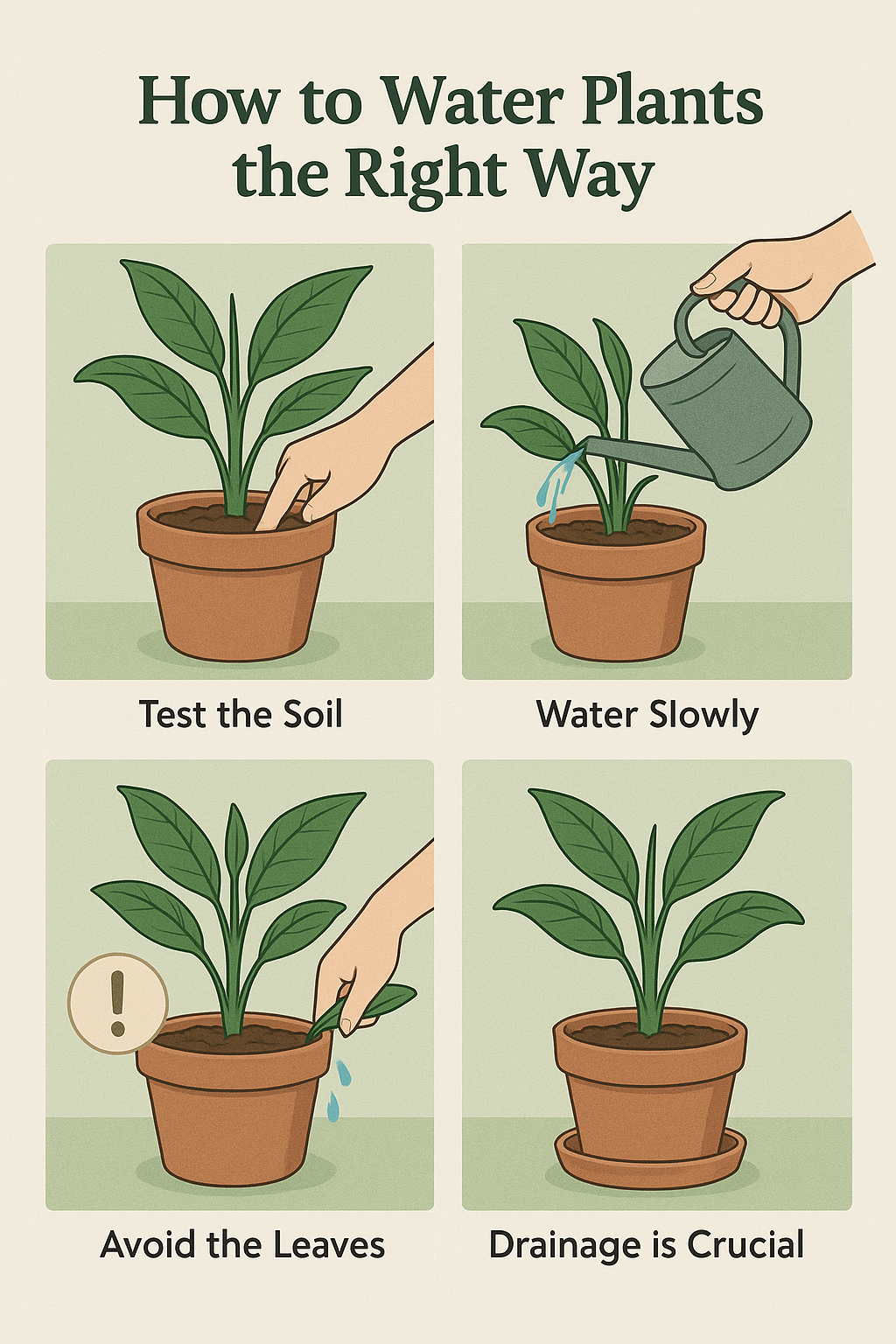Watering your plants correctly is one of the most essential skills for any gardener. Whether you’re caring for indoor houseplants or managing a thriving outdoor garden, understanding when, how, and how much to water can be the difference between flourishing greenery and withered leaves. In this guide, you’ll learn everything you need to know to master plant hydration.
Why Proper Watering Matters
Improper watering—either too much or too little—is one of the most common causes of plant stress or death. When roots are overwatered, they suffocate from lack of oxygen and may rot. Underwatering, on the other hand, leads to dehydration, stunted growth, and crispy leaves.
The Role of Water in Plant Health
- Nutrient Transport: Water helps dissolve and transport nutrients from the soil to the plant.
- Photosynthesis: It’s crucial for producing energy.
- Temperature Regulation: Water cools plants down through transpiration.
- Structure Support: Water keeps plant cells turgid and upright.
How Often Should You Water Your Plants?
There’s no universal schedule, as watering needs vary depending on plant species, soil type, weather, and environment. However, a few general rules apply.
Factors That Affect Watering Frequency
- Soil Type: Sandy soils dry quickly; clay soils retain water longer.
- Plant Type: Succulents need less water than tropical plants.
- Pot Size and Material: Small pots dry faster; terracotta pots absorb moisture.
- Light and Temperature: Bright, warm conditions increase water needs.
Rule of Thumb
Check the top 1–2 inches of soil. If it feels dry, it’s time to water. For potted plants, lift the pot—if it feels unusually light, the soil is likely dry.
Best Time of Day to Water
Morning is generally the best time to water plants. It allows water to penetrate before the heat of the day causes evaporation and gives leaves time to dry before night, reducing the risk of fungal diseases.
Signs You’re Overwatering or Underwatering
Overwatering
- Yellowing leaves
- Mushy stems
- Fungus or mold on soil surface
- Root rot (black, mushy roots)
Underwatering
- Wilting or drooping
- Dry, brittle leaves
- Soil pulling away from pot edges
How to Water Plants the Right Way
Step-by-Step Watering Technique
- Test the Soil: Use your finger, a moisture meter, or a bamboo stick.
- Water Slowly: Let the water soak in deeply to reach the roots.
- Avoid the Leaves: Focus on the base of the plant to prevent fungal issues.
- Drainage is Crucial: Ensure pots have drainage holes. Never let plants sit in stagnant water.
- Use the Right Water: Rainwater is ideal. If using tap water, let it sit overnight to allow chlorine to evaporate.

Special Tips for Indoor Plants
- Use pots with drainage trays.
- Group plants by watering needs.
- Mist humidity-loving plants like ferns and calatheas.
- Place plants away from heat sources or drafty windows.
Outdoor Gardening: Adjusting for the Seasons
Spring & Summer
- Water more frequently, especially during heat waves.
- Early morning is best to avoid scorching leaves.
Fall & Winter
- Reduce watering as plants enter dormancy.
- Be cautious with succulents and cacti—overwatering in cold months can kill them.
Tools That Can Help You
- Moisture meters – Inexpensive and reliable for consistent watering.
- Self-watering pots – Ideal for busy people.
- Mulch – Helps retain soil moisture and reduce watering frequency.
🔗 Looking to buy a moisture meter? You can find one here: Amazon – Soil Moisture Sensor Meter
🔗 Want to explore pot ideas for your indoor garden? Check out this internal guide: Best Pot Combinations for Indoor Aesthetics
Want to learn how much sunlight each of your plants really needs? Read our complete guide on understanding sunlight requirements for each plant.
Conclusion: Water Smart, Grow Strong
Mastering plant hydration isn’t about watering more—it’s about watering better. Every plant has unique needs, and by observing your environment, adjusting your habits, and applying the techniques shared in this guide, you’ll give your plants the best chance to thrive.
Take action today: Test your soil, adjust your watering schedule, and invest in helpful tools. Your plants will thank you with vibrant growth and healthy blooms.
FAQ – Frequently Asked Questions
How do I know if I’m watering my plants too much?
If your plant’s leaves are turning yellow and the soil is constantly wet, you may be overwatering. Check the roots—black or mushy roots indicate rot.
Can I use ice cubes to water plants?
While some people use ice cubes for orchids or small pots, it’s not ideal. Sudden cold can shock roots. Use room temperature water instead.
Should I mist my indoor plants?
Yes, but only certain types like ferns, calatheas, and air plants benefit from misting. Avoid misting succulents or hairy-leafed plants.
To ensure your plants get the right amount of moisture, consider using a reliable soil moisture meter like this one available on Amazon.

[…] To prevent many of these plant diseases, it’s essential to water your plants correctly — check out our complete guide on watering plants the right way. […]
[…] Want to ensure your plants are properly hydrated before applying fertilizer? Read our complete guide on watering plants correctly. […]
[…] Want to master one of the most important parts of this routine? Learn all the essentials in our guide to watering plants correctly. […]